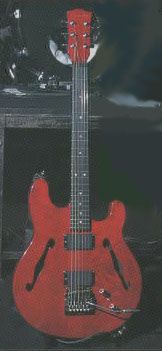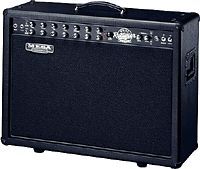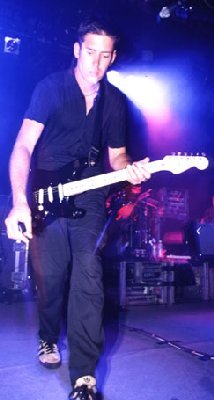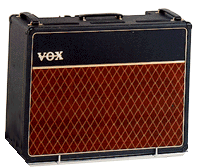Techniques
..................................
Ed is responsible
for the background buzz during "My Iron Lung".
He achieves the sound using both an E-bow and his Strat's whammy bar. The
E-bow provides the sustain and the whammy bar is used to help create the
gradual up/down swell in pitch. A similar technique is used during Talk
Show Host too (live at least).
The effect Ed
creates towards the end of Talk Show Host may
be produced using a Lovetone Meatball, which is a terrific (ally expensive)
envelope filter which, among many other things, can turn out that nice
auto-wah which resembles record scratching. They're made in small numbers
in the UK and go for a little over $300 US currency. If you want something
similar and can't find the Meatball, consider an old Mu-Tron envelope filter
(again, if you can find one) or, failing that, the newer Sovtek/Electro
Harmonix Q-Tron.
"Karma Police"
distorted guitar dropouts, courtesy of a rackmount AMS digital delay. "That
machine malfunctions wonderfully," Thom says. "Ed played the notes that
started it, but basically it's the machine playing itself." Ed explains
that the noise was made by turning up the delay's regeneration, then slowly
turning the delay speed down.
The basic effects
unit in ed's rack is a korg a2 multi-fx, although it's fallen out if favor
for the more analogue sounds of ok computer. "i used it a lot on the bends,
stuff like planet telex - almost all the guitar is through that, all very
synthesized." next up is a digitech whammy pedal - "everyone seems to have
one of those, but they're great." then there's an old mxr phaser pedal,
jim dunlop tremolo, a companion distortion pedal, electro harmonix small
stone and electric mistress, plus roland space echos and "the usual" boss
pedals. for guitars, ed has tree rickenbacker 360s, a 12-string black model
and two sunburst six-strings, a couple of strats ("just for on the road,
they're really solid for fx-stuff"), and a hand-built guitar made by the
band's guitar tech, peter clements. it's a hybrid of a gibson neck with
a rickenbacker semi-acoustic body ("a beautiful, beautiful guitar," ed
adds).
The thinking
behind the use of so many standalone pedals is simple - it opens the doors
to sonic experimentation big-time. "it's how you use them, in what order
you put them," as ed puts it. "out in america we pick up loads of stuff
from second-hand stores, funky old pedals. we've got a great fuzz pedal
- the bass on exit music, the distorted bass at the end was a 60's japanese
fuzz pedal that i picked up in la. it's a great pedal. 60 bucks for this
thing - you put it on a guitar and it sounds like telstar."
"Or jonny at
the end of paranoid android, the phased solo thing, that's through a mutator
- he did the part then fed it back through the box and played with the
settings."
Another good
example is the background sound in the verse and intro to lucky - it sounds
like a typical o'brien creation. "i remember fiddling around in the soundcheck
- we were in japan - and putting together a different pedal order and actually
hitting the strings above the nut on the headstock. the pedals that i did
it with, and the delay that was going on. it was one of these moments -
'yeah, this is pretty cool.'
as for the rest,
everyone plays fenders - colin plays a precision bass, jonny a telecaster,
there are fender twins amps everywhere. thom uses a fender jazzmaster and
a telecaster custom - one of the 1970's ones with two humbuckers and a
strat-style headstock. "yeah, but he's just bought a rick. he's wanted
one for ages because i had one," ed adds with a smirk.
on the amp side
the band use mainly reissue valve models - "in the studio it's ac30s, fender
twins and a boogie rectifier, the tremoverb, which is really nice. they're
all reissue ones, we haven't got any old amps - we do so much touring they'd
probably break down too much. so we got the reissue blue speaker voxes.
i'd love to hear a great old 1960's vox, though, i've never heard one." |



 box
box  pedal
pedal


